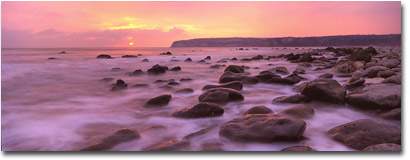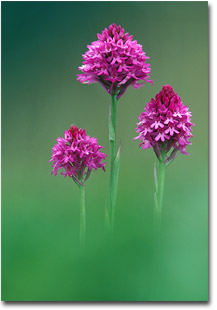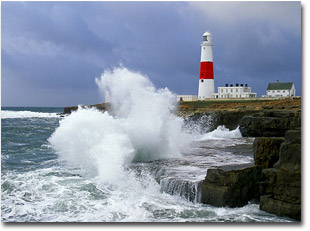|
|
 The Jurassic Coast
Text and photography Copyright Guy Edwardes The breathtaking coastline of Dorset and southeast Devon has long been regarded as one of the most scenic parts of the British Isles. No other stretch of the UK shoreline exhibits such a varied range of landforms and geological diversity. In
This stretch of coast is considered to be the only place in the world visibly displaying unbroken evidence of 185 million years of earth’s evolution and history and, as such, provides a unique walk through time. Cliff exposures are tilted from west to east providing an almost continuous sequence of Triassic, Jurassic and Cretaceous rock formations spanning the Mesozoic era and include some internationally important fossil sites that continue to produce well-preserved evidence of life during this important stage of earth’s evolutionary history. The predominance of shallow water sediments laid down over millions of years accounts for the exceptionally diverse range of fossil types to be found; showing the evolution of many species including plants, insects, fish, marine invertebrates, marine and terrestrial reptiles and prehistoric mammals. These important fossil sites and geological features have contributed to the study of earth sciences for over 300 years.
A diverse range of rock types is responsible for the vastly contrasting appearance of the landforms. In places rock formations have been thrust on to their sides exposing a natural time-line, the contorted layers of limestone are a testament to the immense forces that went into shaping the landscape here. Imposing red sandstone cliffs plunge into the sea at the western end of the Jurassic Coast, in contrast to the pure white chalk cliffs in the east. In between lays an incredibly varied coastline of rocky shores, shingle beaches, estuaries, sandstone cliffs, and limestone headlands. In places spectacular landslips have opened up thickly wooded and virtually impenetrable gorges that are a haven for wildlife. Elsewhere limestone rocks display dinosaur footprints, along with the fossilised remains of ancient forest trees. This diverse geology gives rise to superb scenery, abundant wildlife and, through the use of local building stone, picturesque villages. The Jurassic Coast may be a mecca for geologists and Palaeontologists from around the world, but it is also a superb area for coastal landscape and nature photography. There can be few places where such a diversity of landforms and habitats can be found on a stretch of coastline less than 100 miles long. There are many individual locations offering great potential for dramatic and atmospheric images. Some are easily accessible whilst others require quite long and often strenuous hikes. The southwest coastal footpath runs the whole length of the Jurassic Coast providing far-reaching views along the humpbacked ridges as they plunge into the sea. There are plenty of side paths that run down to the shore, enabling exploration of some of the more remote coves and headlands. The best time for coastal landscape photography is undoubtedly between October and March when the sun rises and sets over the sea, casting its first and last rays of warm light across the cliffs and shoreline. At this time of year the throngs of tourists that crowd the beaches and the most popular beauty spots throughout the summer months can be avoided. It is, however, still possible to find quiet secluded coves and beaches away from nearby roads and car parks, especially early and late in the day, even during the height of the tourist season. Coastal wildflowers are found in abundance all along the coast throughout spring and early summer; particularly good areas include the Isle of Purbeck, Portland’s disused quarries and the Chesil Beach. The same locations are home to many species of butterfly. The RSPB reserves at Radipole Lake and Lodmoor near Weymouth are both excellent sites for bird photography and can provide close encounters with species such as bearded tit, Cetti’s warbler and water rail. The nearby Fleet lagoon harbours large numbers of wintering wildfowl and waders and, at its western end is the famous Abbotsbury Swannery - the swannery is open to the public from mid March to the end of October and provides access to large numbers of mute swans and their cygnets. Further east between West Bay and Burton Bradstock the vertical sandstone cliffs are home to nesting northern fulmar - the cliff-top path providing a useful vantage point from which to photograph them in flight. It is important to remember that many parts of this coastline are extremely hazardous - I speak from experience having had some rather close encounters myself over the years! Rock falls are frequent and unpredictable along much of the coast throughout the year. Consequently it is best to avoid walking close to the base of any cliffs even though this means that some areas will be inaccessible around high tide. Similarly, the cliff tops are also unstable so it is best to stay well back from the edge. The mudflows in the west of the region can be particularly dangerous during and after wet weather. This unique and beautiful stretch of the UK coastline has much to offer the nature or landscape photographer in an accessible area that can be easily explored from a central base such as Bridport or Weymouth. Whenever you visit it’s impossible not to be inspired by some of the most spectacular coastal scenery the British Isles has to offer. HIGHLIGHTS OF THE JURASSIC COAST Old Harry Rocks and The Pinnacles, Ballard Down, near Swanage An excellent location for coastal landscapes, especially early in the morning when the rising sun casts warm light on the chalk cliffs and sea stacks. The cliff top grasslands are good for wildflowers and butterflies. Dancing Ledge, near Worth Matravers A steep decent to the shoreline is rewarded by fantastic coastal landscapes, geology and marine life, especially at low tide. St Alban’s Head and Chapmans Pool This headland provides spectacular views along the coast, with wonderful displays of wildflowers in late spring and early summer. The horseshoe cove of Chapman’s Pool and the remote rocky shoreline below St Alban’s Head are well worth exploring. Kimmeridge Bay This is a superb spot for coastal landscapes and geology, especially at low tide late in the afternoon between October and March. There is a very informative visitor centre and lots of rock pools full of interesting marine life. Access is restricted at certain times. Beware of falling rocks. Lulworth Cove, Stair Hole and Durdle Door Good for coastal landscapes and fascinating geological features. These famous landmarks are well worth a visit, but the area gets extremely busy during the holiday season and at weekends. Lodmoor, Radipole Lake and The Fleet, Weymouth These are two excellent RSPB reserves in the coastal town of Weymouth that provide opportunities for bird photography throughout the year. The Fleet is good for wintering wildfowl and waders, although a long telephoto lens is usually required.
Isle of Portland Superb views, interesting geology, picture postcard lighthouse. There are spectacular displays of wildflowers in the disused quarries, along with a variety of insects, during late spring and summer. The Chesil Beach This 30 mile long shingle storm beach protects the fleet lagoon from the Atlantic. Many unusual and colourful plants can be found here, especially on the causeway between Weymouth and Portland. Abbotsbury Swannery The only managed colony of free-flying mute swans in the world. More than 600 swans on the reserve include up to 150 nesting pairs (Tel. 0(44)1305 871858). To the west of Abbotsbury on the road to Bridport there are superb views over The Fleet and Chesil Beach. Burton Cliff and East Cliff, near Bridport These are the sheer sandstone cliffs – especially good in the late afternoon when a low spring tide exposes rocky shelves on the beach below. Lyme Regis and the Undercliff Lyme Regis offers many photo opportunities throughout the year, from waves crashing over the famous harbour wall known as “The Cobb”, to fishing boats and sunsets reflected in the tranquil waters of the harbour itself. West of the town is the Undercliff, a ten-mile long National Nature Reserve consisting of ancient landslips blanketed in dense tree and shrub cover that are a haven to many species of flora and fauna. The coastal footpath provides the only access to this area. The Axe estuary A wintering ground to many species of wildfowl and waders, many of which can be viewed at fairly close quarters from the road that runs alongside. Useful information Nearest airports: Bournemouth www.flybournemouth.com and Exeter www.exeter-airport.co.uk Getting around: a car is essential to fully explore the coast www.europcar.co.uk www.hertz.co.uk Accommodation: www.where-to-stay.co.uk www.hotelsintheuk.com www.gorwellfarm.co.uk www.country-holidays.co.uk Useful Web sites
www.jurassiccoast.com Guy Edwardes - NPN 330 Editor's Note - Guy Edwardes is a professional nature and landscape photographer based in southwest England. You can view more of Guy's work on his website at www.guyedwardes.com Comments on NPN landscape photography articles? Send them to the editor. |
|
|




